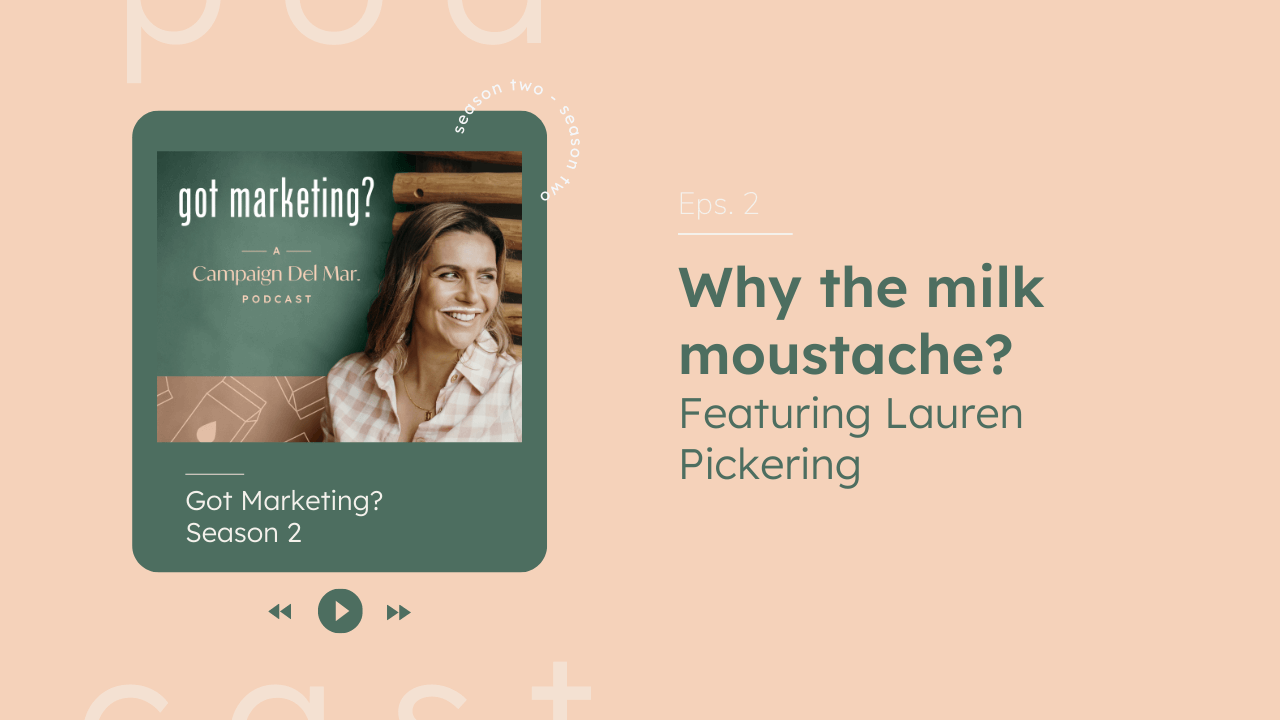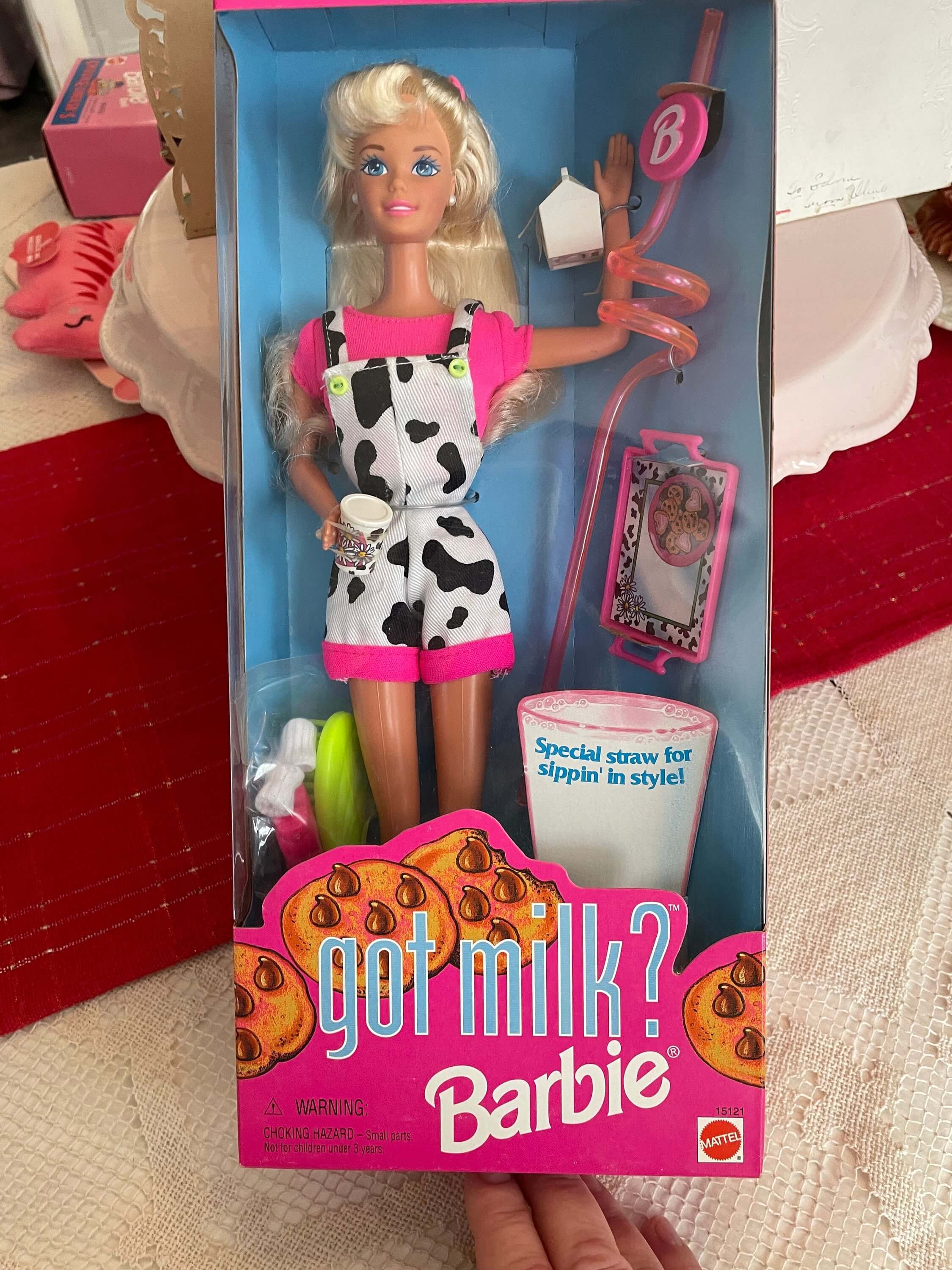What Small Businesses can Learn From the Iconic Got Milk? Campaign
Nov 07, 2022
It's about time we explain the milk moustache in our podcast artwork.
Campaign Del Mar’s podcast name, Got Marketing? – was inspired by the iconic “Got Milk?” campaign. While there are many iterations of the Got Milk? campaign, the most famous are images of celebrities and thought leaders with milk moustaches. Hence, the name, the milk cartons, and the milk moustache in our podcast cover art.
I was joined on the podcast by guest Lauren Pickering, a professional marketer with 15 years of experience across consumer brands, education and professional services, to talk about this marketing masterpiece.
We live in an era of clickbait – cheap tricks to get momentary attention. While most advertising is regarded as disposable – with a shelf life of only a few months, if you’re lucky – “Got Milk?” has endured for more than a decade since it was first released in 1993.
Here, we summarise what Lauren and I discussed and what small businesses can learn from this iconic brand awareness campaign.
Shift with the Times
For so long, the milk industry dominated the beverage consumption category, relying on the promise that milk is good for you. All over the world, milk was promoted as a wholesome drink; it was endorsed by health professionals and served at school cafeterias in the US.
But in the 70s and 80s came the Pepsi and Coke "effect.
“They [Pepsi and Coke] came along and they aggressively positioned their beverages. They positioned them with celebrities. They were fun, sexy, and youthful. They made milk look boring – buying it, drinking it, everything about it.” - Lauren Pickering
Soda became the beverage of choice.
The milk industry could no longer market milk the way it had been.
“What was working for milk was no longer cutting the mustard.” - Lauren Pickering
The Got Milk? campaign took milk marketing in a new direction to adapt to this societal shift.
So what’s the takeaway for small businesses?
“… don’t just roll over and repeat year on year the things that have worked for you in the past. Milk was doing that for about a decade while Pepsi and Coke came onboard and really took a big share [of beverage consumption].
I never like to focus too much on what competitors are doing because they’re them and you’re you, but you’ve got to keep an eye on them, so keep an eye on your competitors – not just your close competitors. What’s broadly happening in society at the moment?” - Lauren Pickering
Insight-Driven Campaigns are the Best Campaigns
All marketing should be insight-driven, and all big ideas should be based on a human truth. No one thinks about milk until you run out. That is a human truth.
The advertising agency responsible for the original Got Milk? campaign, Goodby Silverstein, developed the campaign idea by taking a step back and observing behaviours towards milk in US households.
The story goes that ‘the big idea’ originated from the agency putting a hidden camera in their staff kitchen and observing their own staff’s behaviour with milk. There, they experienced the pain point – the deprivation of running out of milk.
What’s so fascinating about this campaign is that it almost coined the term “deprivation marketing” - no one gives a flying ship about milk until you don’t have it. That’s a really powerful insight but also a very powerful human behaviour.
“Creating a problem that people don’t know of, or that they don’t know exists, is one of the most powerful roots of a marketing campaign that works.“ - Lauren Pickering
And so, they came up with the very simple, grammatically incorrect slogan – “Got milk?” – which allowed the audience to become problem-aware.
This also goes to show that you don’t need a big budget to uncover customer insights.
“It [the campaign] was anchored in customer insight, but that insight wasn’t from a big, expensive market research project to validate the idea. They [Goodby Silverstein] did do it because they had the money to do it, but it was based on observation, gut feel, and I think any marketer, or any business owner really, should spend time to observe people in their natural habitats and just watch. There’s a real power in observation as a market research tool.” - Lauren Pickering
Image via Goodby Silverstein & Partners
The Importance of The Big Idea
The hero concept for a campaign – ‘the big idea’ - must be meaty enough to have longevity and work across various tactics and channels.
“You have to stress test that big idea. Will it work in the many different ways you see it rolling out?” - Lauren Pickering
Got Milk?
This grammatically incorrect question became the big idea that was used across dozens of different creative executions. Some were quirky, and some were a little more straight shooting.
You don’t want your campaign to be a one-hit-wonder. Customers don’t take action after seeing something once.
The business objective for the Got Milk? campaign was to generate milk sales, but when you dig below the surface, it was a behaviour change campaign. They needed people to stop choosing soft drink and go back to reconsidering milk. That kind of behaviour change can take a long time.
One campaign creative and one TVC are not going to get the job done.
This really speaks to my love of campaigns. When you hit on gold, it can feed your audience for decades – like this one!
Take Creative Risks
This campaign took huge creative risks. They hired an up and coming director to shoot the first television commercial for the Got Milk? campaign. He was nowhere near as well-known as he is today.
They asked Michael Bay, who later went on to direct Pearl Harbour, Armageddon, and a whole bunch of other blockbusters - to direct this television commercial, and it was as quirky as it gets.
It was set in a dingy cellar room. We see this fanatical guy who’s obsessed with American Civil War history. He’s about to win a radio competition, all he needs to do is answer the question, and he knows the answer. It's the question he's been dying to be asked: who killed Alexander Hamilton?
However, he has just taken a bite out of a peanut butter and jelly sandwich and goes to take a swig out of a milk carton to wash down the sandwich… and the milk carton is empty.
He's unable to answer the question because his mouth is dry. This is soul-crushing. The plot is ridiculous, but it works. I have watched it recently and thought, “this is crazy but genius.”
It connected to the insight of how frustrating it is when you run out of milk. No one thinks about milk until they need it, so you should always have milk in the fridge!
Sometimes, you need a little help in developing a creative campaign idea.
“Sometimes, if you’re running your own business or working internally on a brand, you’ve got to get the lens and the views and the opinions of others. It wasn’t the milk industry who came up with this idea; it was their advertising agency partners.” - Lauren Pickering
Coming up with campaign ideas is what we help our customers do at Campaign Del Mar. During Campaign Classroom, Mia and the team work with each student to ideate a clever, creative and insight-driven campaign that is suited to their business.
We don't just give them the ideas; we teach them how to flex their own creative muscles and brainstorm non-boring marketing ideas. These are tools that serve business owners and marketers for life.
“When I’m in a creative meeting, and something makes me feel a tad bit uncomfortable, I know that we’re onto something because, if I’m feeling completely comfortable, it’s too obvious.” - Lauren Pickering
The Power of Collaboration Marketing
The most famous iteration of the Got Milk? campaign would have to be the milk moustache print advertising launched in 1993 by the California Milk Association, and later licensed to the National Milk Association. You’ve seen them. The ones featuring celebrities sporting a milk moustache, and the Got Milk? tagline.
“You’re talking about celebrities like Britney and Jennifer Aniston and David Beckham. You’re talking the who’s of the who. Harrison Ford. Mandy Moore. They went beyond humans. They went into characters with Superman. They even went to Kermit the Frog. This quickly became not an advertising campaign but a cultural moment in time that still lasts today.” - Lauren Pickering

(Image: Milk Processor Education Program)
These print ads were not the only other component of this campaign. The collaborations are an often overlooked part of the Got Milk? campaign.
The “Got Milk?” tagline was licensed to Oreo and Honey-Nut Cheerios.
"Cereal, milk – tick. Cookies, milk – tick. But they went beyond that. There’s a “Got Milk?” Barbie out there with a cow print dress and a gift with purchase curly super straw. I love that they went a little off centre with their licensing and partnerships.
What rings true today about that is that collaboration marketing is where it’s at. That’s where you can really find new audiences, new messages, new associations, new markets really quickly, but it has to have a point of benefit for both brands. For milk, they don’t need to drive awareness of milk. They needed to change the perception of milk in some ways.” - Lauren Pickering
But just like this campaign shows us, you need to go beyond the obvious.
Everyone collaborates the same way. “We’ll do a limited-edition product. We’ll do limited-edition packaging. We’ll do an event.” But if you can really do something attention-grabbing, then – guess what? – you’re going to get attention! Creativity is the future of business advantage.
Limited edition Got Milk? Barbie (Image via Etsy)
Even a Brilliant Marketing Campaign Won’t Solve All Your Problems
Was the Got Milk? campaign successful?
”Did it work in terms of pure sales? Well, in the year or two after the campaign, the gallons of milk sold in California went up. Great. But milk consumption over the next ten or so years went down. Sales went down, too. I guess my question would be, did they maximise the opportunity to halt a trend that was already declining, and did they adjust that line? The data says, yes, they did. They stopped what could have been a 200-plus million-dollar decline and saved that to be a 20-odd million-dollar decline.
Did they, however, find a way to create a new problem or a situation to grow consumption in lieu of the drinking milk that they were losing to soda? No, they didn’t find that opportunity.” - Lauren Pickering
We know now - and the milk industry probably knew back then - that milk consumption in the traditional sense was never going to be the same as it was before it was disrupted by the soda industry.
The campaign may have worked in slowing down the inevitable demise of milk. But at the end of the day, the best marketing campaign in the world can’t save a dinosaur industry.
Customer behaviours and customer preferences have changed. I’m lactose intolerant. I can’t drink milk, and neither can many people. This was inevitable. I definitely don’t blame the marketing.
I will always hold Got Milk? up as a marketing masterpiece. I think that it did the best job it could do but at the end of the day, we need to remember the four Ps of marketing. Marketing is more than just the promotional element. It’s the product. It’s the price. It’s the distribution strategies. All of those things influence the ultimate success of a product or service.
If you want to tap into the power of marketing campaigns and leave a lasting impression like the Got Milk? campaign, then you are in the right place, friend! If you are new to marketing your business, then your best bet is to start with the Setting the Stage for Campaigns mini-program, where we get you ready to run campaigns in just 4 weeks. If you are an experienced marketer or business owner ready to run campaigns, then Campaign Classroom is for you. Over 10 weeks, we create an integrated marketing campaign that converts.
By Mia Fileman
Listen to the full episode here, or via Spotify or Apple Podcasts.

Written By
Mia Fileman
Marketing Strategist

Author
Mia Fileman
Marketing Strategist and Founder




